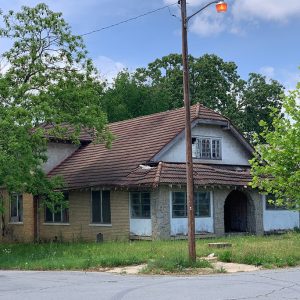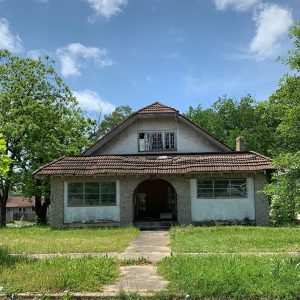calsfoundation@cals.org
Scipio A. Jones House
The Scipio A. Jones House is a 1928 Craftsman-style residence on Cross Street in Little Rock (Pulaski County) that was the home of Scipio Africanus Jones, a renowned African-American attorney, and his second wife, Lillie. It was listed on the National Register of Historic Places on May 28, 1999.
Jones was born a slave in 1863 near Tulip (Dallas County). Moving to Little Rock around 1881, he attended Walden Seminary (now Philander Smith University) in Little Rock and Bethel Institute (now Shorter College) in North Little Rock (Pulaski County) before passing the bar in 1889.
Jones would practice law in Little Rock for the remainder of his life, with his most noteworthy case being the defense of the so-called Elaine Twelve, made up of African-American men who were convicted of murder in the 1919 Elaine Massacre and sentenced to death; he succeeded in having all twelve men eventually released. A leader in Little Rock’s black community, Jones was also active in business and Republican Party politics.
Jones lived in several Little Rock houses when he was single but moved into one at 1808 Ringo Street after marrying Carrie Edwards in 1896. After she died in 1908, he and his daughter Hazel moved to a house at 1822 Ringo. In 1917, he married Lillie Jackson of Pine Bluff (Jefferson County), and they moved into a house at 1911 Pulaski Street in Little Rock.
In 1928, Jones had an elaborate Craftsman-style house built at 1872 Cross Street. The structure included brick, stucco, tile, and granite in addition to a clipped gable on the second story and the exposed rafter tails that distinguish the Craftsman style. Architectural historian Cheryl Griffith Nichols noted that “the variety and quality of the materials used in the home’s construction—brick, stucco, tile, granite—distinguish it from its neighbors and indicate that it was built for a person of more than average means.”
Jones died in the house on March 28, 1943, as did his wife a few years later. The house was purchased by a family whose members still owned it when it was added to the National Register in 1999. By the late 2010s, however, the Scipio A. Jones House had stood vacant for several years and was in serious disrepair. Preserve Arkansas, a statewide historic preservation nonprofit, listed it among Arkansas’s most endangered historic places in 2019. The house was further damaged by a fire in early 2020.
For additional information:
Jenkins, Cary. “History at Risk: Scipio A. Jones House Is in Danger of Demolition.” Arkansas Democrat-Gazette, May 27, 2019, p. 1D.
Nichols, Cheryl Griffith. Historically Black Properties in Little Rock’s Dunbar School Neighborhood. Little Rock: Arkansas Historic Preservation Program, 2013. Online at https://www.arkansasheritage.com/docs/default-source/ahpp-documents/local-historic-contexts/dunbar_new11f1ae89-855f-45ae-9b52-48d61c78f359.pdf?sfvrsn=9ffbbf6b_5 (accessed August 5, 2021.)
———. “Scipio A. Jones House.” National Register of Historic Places registration form. On file at Arkansas Historic Preservation Program, Little Rock, Arkansas. Online at http://www.arkansaspreservation.com/National-Register-Listings/PDF/PU9832.nr.pdf (accessed November 13, 2019).
“Seven to Save: The 2019 List of Arkansas’s Most-Endangered Historic Places.” Preserve Arkansas. https://preservearkansas.org/wp-content/uploads/2016/05/MEP-Press-Packet-2019-compressed.pdf (accessed November 13, 2019).
Mark K. Christ
Central Arkansas Library System
 Early Twentieth Century, 1901 through 1940
Early Twentieth Century, 1901 through 1940 Historic Preservation
Historic Preservation Scipio A. Jones House
Scipio A. Jones House  Scipio A. Jones House
Scipio A. Jones House 




Comments
No comments on this entry yet.